
Orlando Florin Rosu - Fotolia
Composable benefits from infrastructure-as-code techniques
Learn why composable infrastructure is an effective infrastructure as code delivery model and can serve as a foundation for orchestrating and automating IT resource provisioning.
A big advantage of composable infrastructure is its support for infrastructure as code, a methodology for automatically provisioning and configuring resources through the use of definition files. Composable architecture provides the foundation necessary to orchestrate and automate resource provisioning. Together with how infrastructure as code benefits IT, it helps address the challenges that come with deploying modern applications, which can be difficult to accommodate with traditional approaches to infrastructure.
By combining infrastructure as code (IaC) with a composable infrastructure, administrators no longer need to manually deploy and configure IT resources to meet application requirements. This helps reduce costs, shorten time to market and improve consistency across environments.
But before IT teams start implementing IaC on a composable platform, they should understand how infrastructure as code works and how it fits into the larger composability picture.
Understanding infrastructure-as-code benefits
Infrastructure as a code benefits development and operations teams by enabling the automatic provisioning technology stacks through software. IaC does this by using a high-level descriptive coding language to create machine-readable definition files. With IaC, a development team can automatically provision and configure resources for a specific application by creating the definition files when building the application. They can also store the IaC and application files in the same version control repository.
Development and operations can use IaC to provision and configure a wide range of compute, storage and network resources, including virtual machines and VPNs. They can also use infrastructure as code to install software such as database systems, as well as verify or adjust settings such as security access controls. Definition files are not the same as the scripts used by IT to automate repetitive, static steps. The IaC approach to provisioning is more flexible and versatile, helping to streamline operations throughout an application's entire lifecycle.
When creating the definition files, developers specify which resources are required to support the application. Definition files might verify that an environment is properly configured, specify how to set up the environment or provide a combination of both. Tools that support IaC then use the files to carry out the provisioning and configuration tasks. As part of this process, the tools also support such operations as orchestration and monitoring.
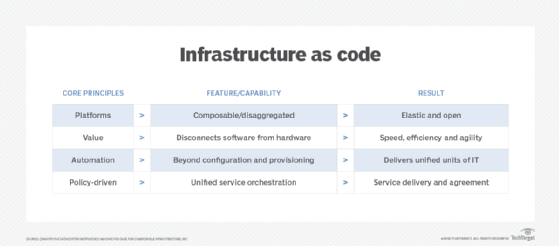
Typically, IaC tools use either a push or pull method to provision and manage resources. In the push method, a centralized controlling server sends the information to the resources that need to be configured. In the pull method, the resources request the configuration information from the controlling server. Many tools default to one method or the other but still support both. For example, the Ansible deployment and configuration tool defaults to the push model, but it can also be configured to use the pull model.
Infrastructure-as-code tools usually take a declarative or imperative approach to programming, with some supporting both models. The declarative approach focuses on the intended outcome, leaving it up to the IaC software to determine the steps necessary to achieve the desired state. The imperative approach defines a sequence of commands that must be executed to reach the desired state. For instance, the Chef automation tool is primarily an imperative tool but also supports declarative IaC.
There are advantages and disadvantages to both the push and pull models and to the declarative and imperative models. There is also plenty of debate about which approaches are best. Organizations evaluating IaC tools should fully understand the differences between these approaches and which ones best suit their environments, taking into account the applications they plan to run, the level of expertise they have on hand and the types of technologies they've already deployed.
DevOps and infrastructure-as-code benefits
Regardless of the how IaC is implemented, it can offer a number of benefits, especially when it comes to DevOps. In fact, many DevOps teams view IaC as an essential ingredient to streamlining operations, as infrastructure as code can be integrated seamlessly into the continuous integration and continuous delivery pipeline, providing consistent application environments throughout the development, testing, staging and deployment phases.
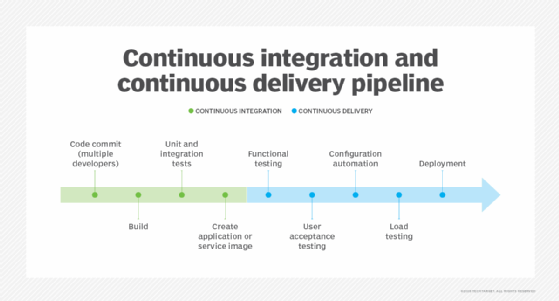
The IaC configuration files reside in version control along with the application files. Not only does this protect IaC files, but it helps tie infrastructure provisioning and application development into a more unified process. Infrastructure as code also helps by speeding up operations and increasing productivity, resulting in more efficient development and faster time to production. It also ensures a more consistent application environment across deployments, while gaining the advantage of secure source control, which provides transparency, accountability and full traceability of all changes.
In addition, IaC can reduce the risks that come from cyberattacks, natural disasters or employee turnover. This is because the provisioning process is documented within the IaC definition files themselves, which are protected along with the application files. Infrastructure-as-code benefits also include cost savings, because it reduces the time and effort needed to provision infrastructure, while helping to better utilize resources than traditional approaches.
Infrastructure as code is not without challenges, however. It requires additional skills and tools to implement, and there can be a steep learning curve depending on the organization and circumstances. Errors can quickly proliferate across environments, undermining many of IaC's advantages. Individuals can also introduce risks if they manually change an environment, which can jeopardize application deployments.
Organizations that want to incorporate IaC into their processes must ensure they understand how it works and properly prepare for its implementation by training participants accordingly.
Data center convergence and IaC
Selecting the proper tools is critical to a successful IaC deployment. But that's not all it takes. An organization must also have an infrastructure in place to accommodate IaC operations.
In the past, data centers typically employed multi-tiered architectures to host and deliver applications. However, this approach lacked flexibility, was inefficient and resulted in poor resource utilization. Although virtualization helped to streamline management and better utilize resources, it did little to change the fundamental nature of the multi-tier approach.
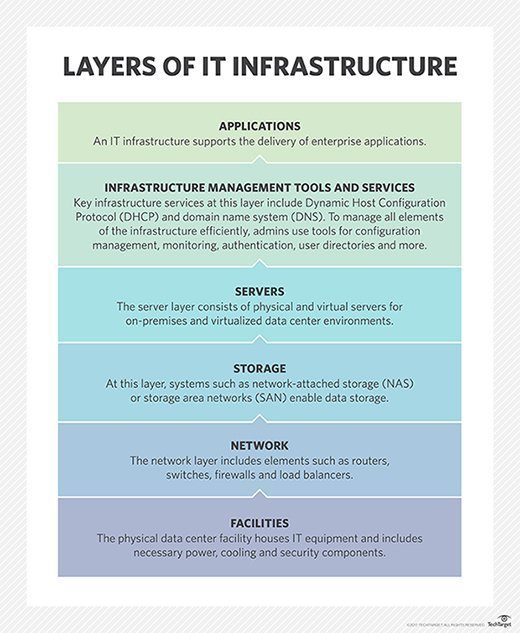
As modern applications worked their way into the data center, they brought with them greater complexities. This required faster deployments and more dynamic workflows, making it increasingly difficult to manage infrastructure in the old ways.
The converged infrastructure helped to reduce IT's load, but it shared many of the same limitations as the traditional data center, such as overprovisioning and lack of flexibility. Hyper-converged infrastructure (HCI) helped address some of these limitations by bringing a software-defined approach to infrastructure, but it still lacked the necessary flexibility and it was subject to overprovisioning. Disaggregated HCI, meanwhile, dealt with some of the overprovisioning issues, but it failed to achieve the required level of agility.
A composable infrastructure offers more flexibility and better resource utilization than converged systems. It provides a software-defined environment that abstracts the physical resources and presents them as a set of unified services. Users can then dynamically compose and recompose these resources to meet application requirements, whether they're running on bare metal, in containers or in VMs. Intelligent software manages the infrastructure, allocates resources and automates service delivery.
By disaggregating the physical resources and presenting them as services, a composable infrastructure provides an extremely flexible environment that offers a number of advantages to organizations running modern workloads. The composable architecture can better accommodate fluctuating requirements and utilize resources more efficiently. It can also run more workload types, even on bare metal, eliminating the hypervisor dependency. In addition, a composable infrastructure does not have to be preconfigured for specific workloads because resources are configured on-demand, and the built-in automation and orchestration helps minimize administrative overhead.
All these features combine to make the composable infrastructure a natural fit for IaC. In fact, composable infrastructure is often referred to as IaC because of how closely they're related. However, this can be misleading.
It's better to think of composability as an expansion of IaC. It delivers a software-defined infrastructure that automatically controls the physical resources with little-to-no human intervention, carrying out such operations as provisioning, configuration and management to meet workload requirements. Composable architecture systems also provide a comprehensive management API that enables third-party tools to interface with the environment.
All of this is exactly what IaC needs.
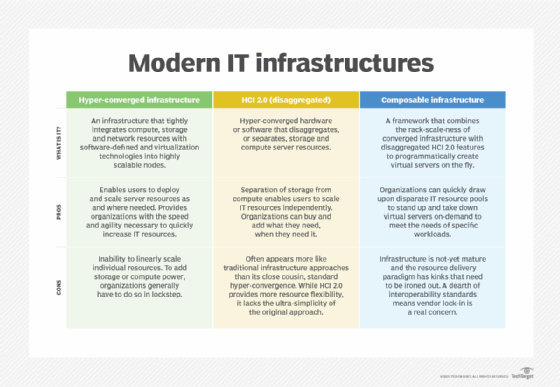
IaC and the composable infrastructure
By using IaC with a composable infrastructure, DevOps has a set of flexible building blocks for composing and recomposing resources on demand, making it possible to implement infrastructure as needed to accommodate their workloads. They start by creating application-specific IaC configuration files, which define the application's requirements. The IaC tools then use these files to assemble the resources on the composable infrastructure.
Infrastructure-as-code tools interface with the infrastructure's management API, which can carry out a variety of operations, such as searching, inventorying, provisioning, diagnosing and updating. With IaC and a composable infrastructure, DevOps can programmatically control any part of the environment, ensuring that their applications always have the resources they need, while reducing the overhead that comes with physically managing each component.
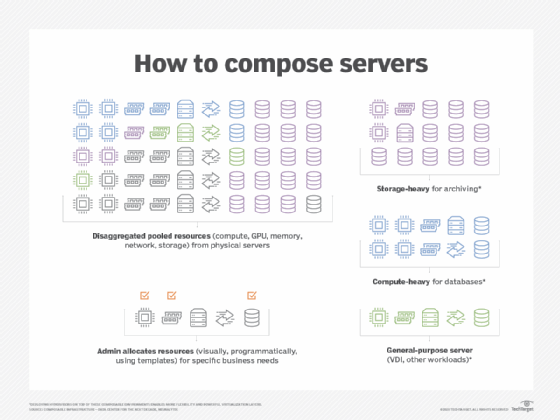
Together, IaC and the composable infrastructure help to form a beneficial partnership that's well suited to today's workloads.








